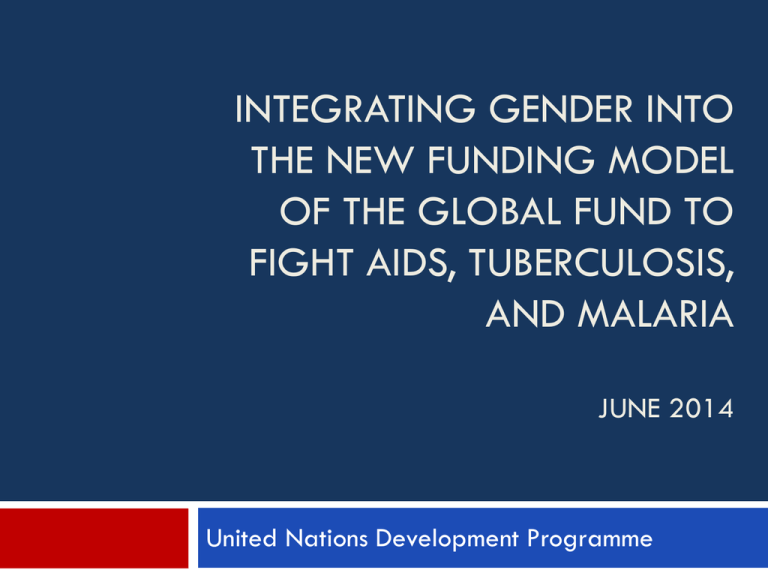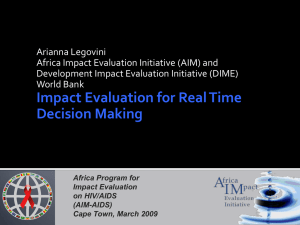
INTEGRATING GENDER INTO
THE NEW FUNDING MODEL
OF THE GLOBAL FUND TO
FIGHT AIDS, TUBERCULOSIS,
AND MALARIA
JUNE 2014
United Nations Development Programme
Together we can…
Index
Gender perspective in the response to HIV, TB and malaria
Understanding the NFM
Integrating Gender into the New Funding Model/checklist
Q&A
Supporting tools for integrating gender into the NFM and NSPs
(UNDP’s “On course”; Whatworksforwomenandgirls.org;
UNAIDS’ gender assessment tool; and UN Women, et.al. gender
and HIV indicators)
Q&A
Experiences of integrating gender into GF processes, including
W4GF
Final Q&A
Gender equality and HIV
Gender & HIV: key facts
The number of new HIV infections among adults in lowand middle-income countries in 2012 was 30% lower
than in 2001.
Still, HIV is the leading cause of death for women of
reproductive age: every minute, 1 young woman acquires
HIV.
52% of all PLHIV in low and middle income countries are
women rising to 58% in sub Saharan Africa
New infections among women are rising in Europe and
Central Asia and the Middle East and North Africa.
UNAIDS Global Report. 2013
Gender and HIV (2)
Though data remains scarce, evidence suggests
that women from key populations are
particularly vulnerable to acquiring HIV
Women living with HIV also face a heightened
risk of cervical cancer
Unequal gender norms undermine effective HIV
responses for men as well as for women
UNAIDS; Francheschi, S. and Guglielmo, R. (2010). The prevention of cervical cancer in HIV-infected women. AIDS,
16: 2579–2580.
Gender and malaria
Gender, TB and malaria
In 2012, about 2.9 million women contracted TB,
410,000 women died of TB
more than half of TB cases among women went undetected,
compared to less than 40% among men. were
50% of PLHIV who died of TB were women
In 2012, pregnant women were four times more likely to acquire
malaria than other adults
In many contexts, men decide who can seek treatment and care for
malaria. Lack of female health care workers often limits women’s
access to treatment and care
PLHIV are at high biological risk of contracting malaria. This rises
to a severe risk for women with dual HIV and malaria
WHO, Fact Sheet on gender and TB
Women and TB
Some relevant gender policies
Gender Equality Strategy of GF (2008) and Action
Plan (2014)
Information note on gender for GF
UNAIDS Agenda for Accelerated Country Action for
Women, Girls, Gender Equality and HIV
UNDP Gender Equality Strategy 2014-2017
Global Fund New Funding Model
Principles of the new funding model
• Bigger impact: focus on countries with the highest disease
burden and lowest ability to pay, while keeping the portfolio
global
Principles
of the new
funding
model
• Predictable funding: process and financing levels become
more predictable, with higher success rate of applications
• Ambitious vision: ability to elicit full expressions of demand
and reward ambition
• Flexible timing: in line with country schedules, context, and
priorities
The country dialogue process is essential to achieving the
• More streamlined: for both implementers and the Global
objectives of the New Funding Model, including with informed
Fund
and meaningful participation of women and key populations
living with and affected by HIV, TB and malaria
http://www.theglobalfund.org/en/events/2014-04-02_Regional_Meeting_Ecuador/
What does country dialogue entail?
Country
Dialogue
The term used by the Global Fund to refer to the ongoing discussion
that occurs at country level to prioritize how to fight the three
diseases and strengthen health and community systems
Country owned process
Ongoing Country Dialogue
Govt-led
National
Strategic Plan
determined by
country
CCMled
Concept Note
PR-led
Grant-Making
CCM/PR-led
Grant
Implementation
3 years
*Country dialogue is a country-owned, on-going process that should include the
meaningful participation of women, girls and key populations
http://www.theglobalfund.org/en/events/2014-04-06_Regional_Meeting_Namibia/
Who plays a role in country dialogue?
Academia
Country
government
Other donors
Global Fund
Private sector
Country Dialogue
Technical
partners
Civil society/
key populations
These actors meet in the CCM, but the dialogue should expand beyond the CCM
http://www.theglobalfund.org/en/events/2014-04-06_Regional_Meeting_Namibia/
Integrating Gender into the New Funding Model
Entry-points for integrating gender
Overview of the UNDP Checklist
Strengthening of National
Strategic Plans
2.
Country dialogue process
3.
Development of concept note
4/5. Independent review by
TRP/Determination of upper
budget ceiling
6/7/8. Grant agreement
1.
*Monitoring and Evaluation
How to use the Checklist
The Checklist provides concrete and practical guidance to
integrate gender transformative components into the
implementation of programmes supported by the Global
Fund
Strengthen attention paid to gender in the implementation
of programmes supported by the Global Fund through the
roll out of the Global Fund’s New Funding Model
Follows the procedures set out in the NFM of the Global
Fund.
A gender-responsive/transformative approach requires
additional actions that can transform unequal power
relations and promote respect for human rights.
Available at: http://on.undp.org/xOcqd (EN, FR, SP)
Gender Checklist for the NFM
Entry points into the NFM
→ Gender-responsive M&E
framework---→ Gender evidence collected
and documented__
→ Ensure gender
prioritiesimplemented---→ Ensure gender
trans’ve approaches
at activity level--→ Include genderresponsive budget
→ Outline gender
responsibilities-of
SSR and SRs-----
1. Strengthening
the NSP
←
←
←
←
Gender Assessment using appropriate Tools
Gender data, targets and indicators
Identify key priorities
Develop timeline
2. Country
Dialogue Process
M&E
Funding for
Gender
Transformative
HIV
Programming
6/7/8. Grant
making/Approval
by GAC/Approval
by GF
3. Concept Note
4/5. Independent
review by
TRP/Determination
of upper budget
ceiling
← Involve gender stakeholders
← Capture recommendations of
consultations
← Include findings from the
gender analysis of NSP
← Capture gender analysis of
NSP
← Define gendered impacts
of HIV, and impact of GBV
← Strong gender-sensitive
proposals
Monitor Fund Portfolio Managers
Keep stakeholders informed of
outcomes
Set out activity costs and funding for
gender
Example 1: country dialogue
2. Alignment of the Global Fund’s process to existing country
dialogue
The process is built on broad and comprehensive
representation of participants, including government, civil
society, and women living with HIV and key populations
The dialogue is designed and implemented to reflect a broad
range of perspectives, including those of people living with and
affected by HIV and key populations, with specific attention to
women and girls
Gender dimensions reflected in the report of the dialogue –
including analysis of the gender dimensions of disease and
recommendations
Example 2: concept note
3. Design and submission of a concept note
Gender assessment/analysis is completed
The concept note includes recommendations for improving attention
to gender dimensions of the three diseases
An investment case has been made for integrating gender-responsive
programming into NSP
Explicit attention has been paid to addressing the needs and rights
of women and girls
Concept note has focused on gender inequality influencing
vulnerabilities of women and men, girls and boys & key populations
A gender sensitive approach has been used in policies and plans for
prevention, treatment, care and support
Linkages between GBV and HIV are addressed based on
bidirectional understanding of HIV and GBV as causes and
consequences as one another
Lessons learned from Zimbabwe
The country was also able to organize a pre-country
dialogue “women’s caucus” meeting and a consultation
with female sex workers.
They were able to identify priority issues for women and
girls to be taken into consideration during the country
dialogue meeting.
There also was an enabling environment, such as the
national HIV strategic plan which recognizes gender and
gender based violence as priority issues.
Women’s representatives were part of the core team
developing a concept note.
Questions and comments?
Key resources
Key Resources
On Course: Mainstreaming Gender into National HIV
Strategies and Plans UNDP.
Available at: http:// on.undp.org/xOcTL (EN, FR, SP)
What Works for Women and Girls
(whatworksforwomenandgirls.org)
Gender assessment tool for national HIV responses UNAIDS. Available at: http://ow.ly/xOd1W
Compendium of indicators of gender equality and HIV.
MEASURE, UN Women, USAID, et.al.
Available at: http://ow.ly/xOdlj
Women4GF http://women4gf.org
UNDP’s “Roadmap”
A step-by-step guide to:
support efforts to systemically integrate gender issues,
factors and concerns into national HIV strategies and plans
develop indicators and track progress in the integration of
gender issues in national HIV strategies and plans
Use of the Roadmap
formulate gender-responsive NSPs
fine-tune and advance plans to reduce gender inequality
and its effects on HIV
What is in the Roadmap?
Specific recommendations for integrating gender
equality into strategies and plans, and to monitor
progress, organized in specific steps that align with a
programming cycle
Methods for designing and costing funding and
budgeting processes, including ToRs and M&E tables
Step-by-step guides to:
1.
2.
3.
4.
respond more effectively to risks of vulnerable groups
identify and eliminate barriers to gender-sensitive planning and
implementation
design and cost gender-responsive budgets
develop gender-sensitive monitoring and evaluation systems
What Works for Women & Girls
28
Compile evidence on interventions - related to HIV
outcomes - that address the needs of women and girls
Translate the evidence into information
that may be useful for programming
Allow access to the evidence
by a wide range of
stakeholders
What Works provides:
29
The broad intervention and
whether the evidence base falls
into “works” or “promising”
The geographic spread of the
intervention (regions/ countries)
References
For each study/evaluation under
the intervention: the country, date,
methodology/sample size, the
intervention, the outcomes and
the strength of evidence
(modified Gray Scale)
What Works Examples: Violence and HIV
What Works:
Community-based participatory approaches to create gender
equity (Abraham et al, forthcoming – SASA; Jewkes et al.,
2006; Colvin 2010).
Promising strategies:
Provision of comprehensive post-rape protocols, which include
post-exposure prophylaxis and emergency contraception (Kim et
al., 2009a; Kilonzo et al., 2009a)
Microfinance programs integrated with training on HIV, gender,
violence (Kim et al., 2009c).
Training teachers about GBV (James Traore et al., 2004).
UNAIDS Gender Assessment Tool
UNAIDS gender assessment tool (2)
Purpose:
To assist countries to assess their HIV epidemic,
context and response from a gender perspective
Identify and develop priority intervention to
make HIV responses more gender transformative
Inform submissions to country investment cases
and GF NFM
The Tool is aligned to national processes like MTR
or development of new NSP, or now to the NFM
concept note development.
UNAIDS gender assessment tool (3)
STAGE 1:
Preparing for the
Gender
Assessment of
the national HIV
response
STAGE 2: Knowing
the national HIV
epidemic and
context
STAGE 3: Knowing
the national HIV
response and
identifying gaps
STAGE 4:
Analyzing the
findings of the
assessment and
identifying
interventions for a
gender
transformative HIV
response
Gender and HIV indicators compendium
What is the indicators compendium?
Purpose: to provide programme managers, organizations and policy
makers with a menu of gender/HIV indicators in order to:
Strengthen national and subnational stakeholders’ understanding of their HIV
epidemic and response from a gender equality perspective
Monitor progress towards eliminating gender-based inequities in HIV
responses
Monitor and evaluate programmes that address specific types of gender
equality interventions in the context of HIV
Divided into programmatic areas
Indicators already exist
Can be measured using existing data collection and information
systems
Conceptual framework
Questions and comments?
United Nations Development Programme, April 2014






